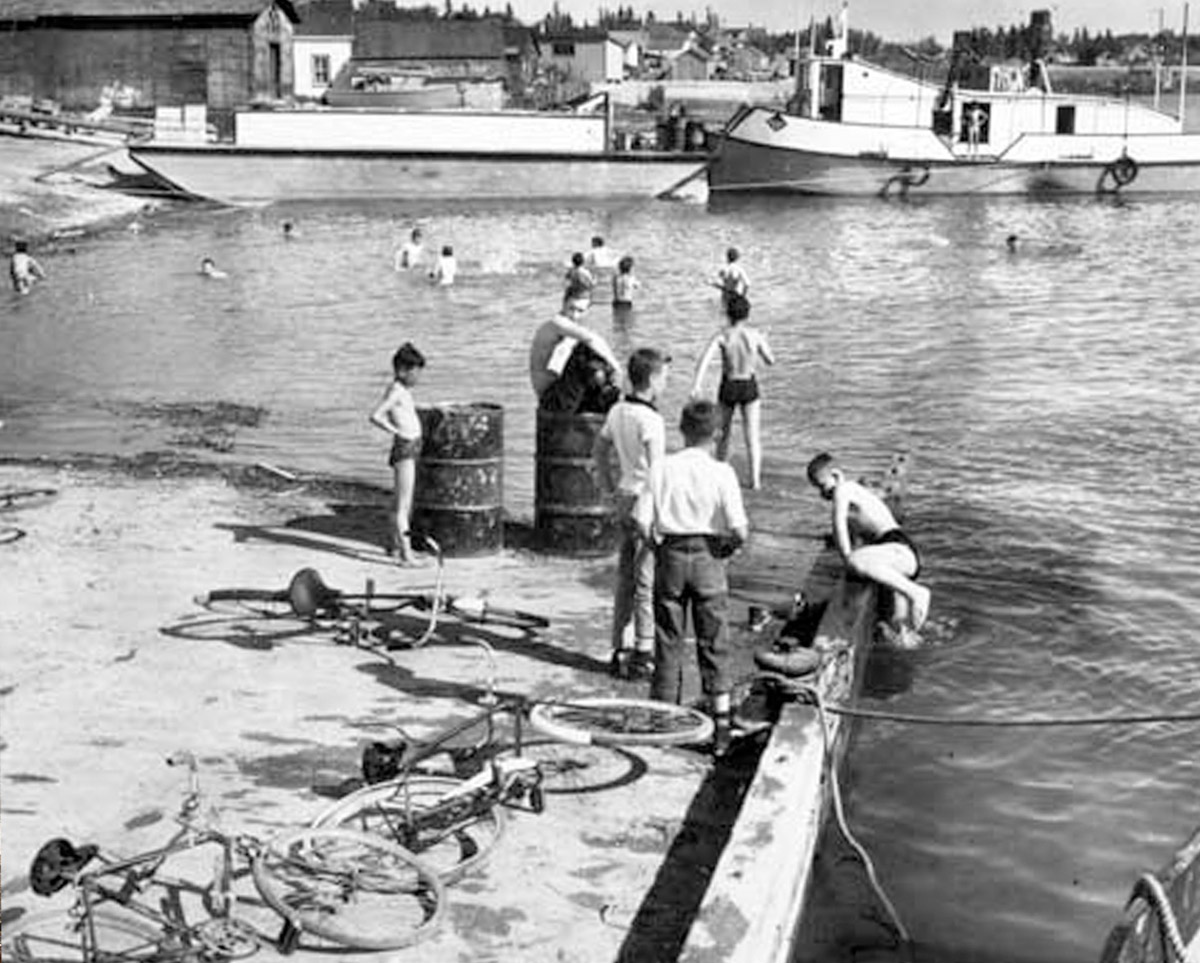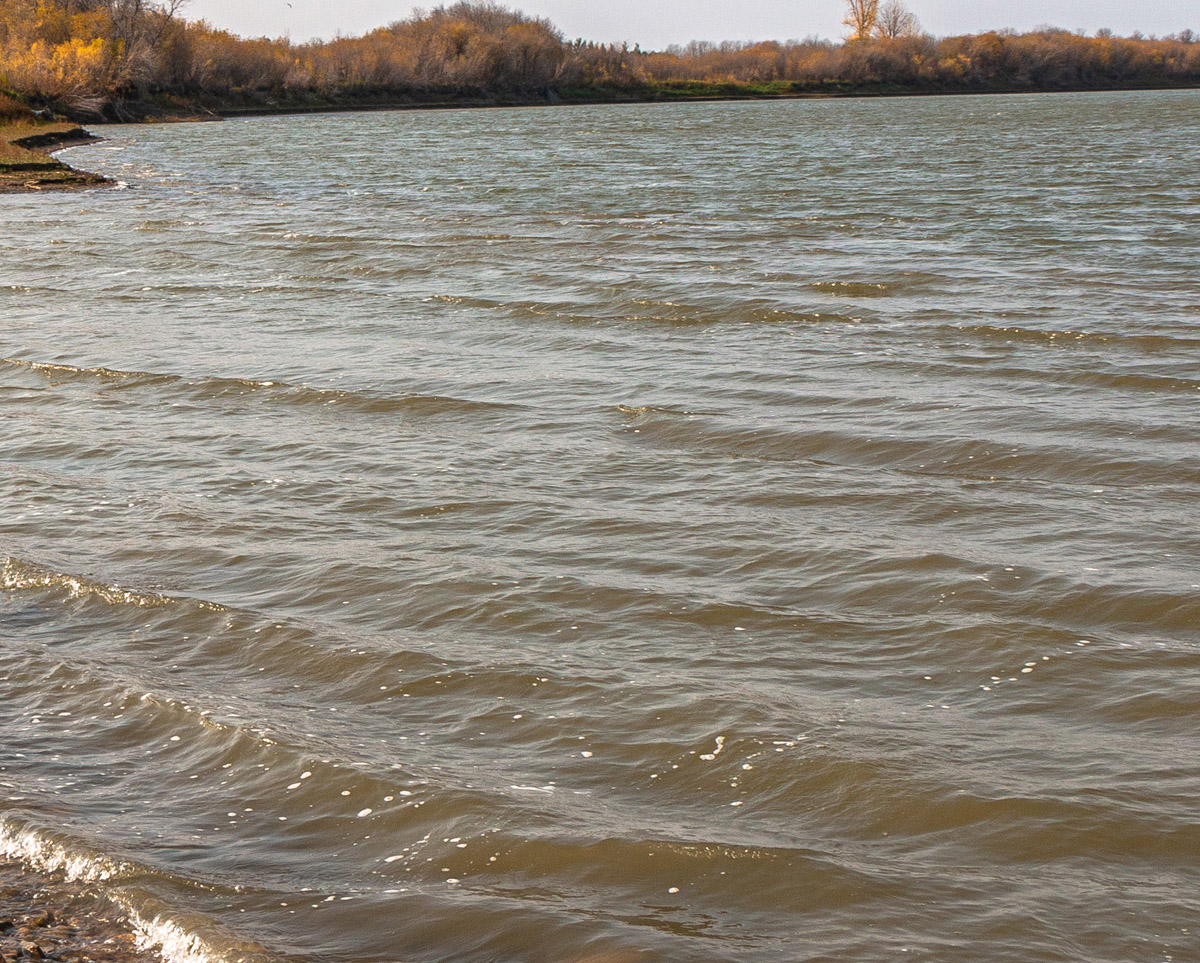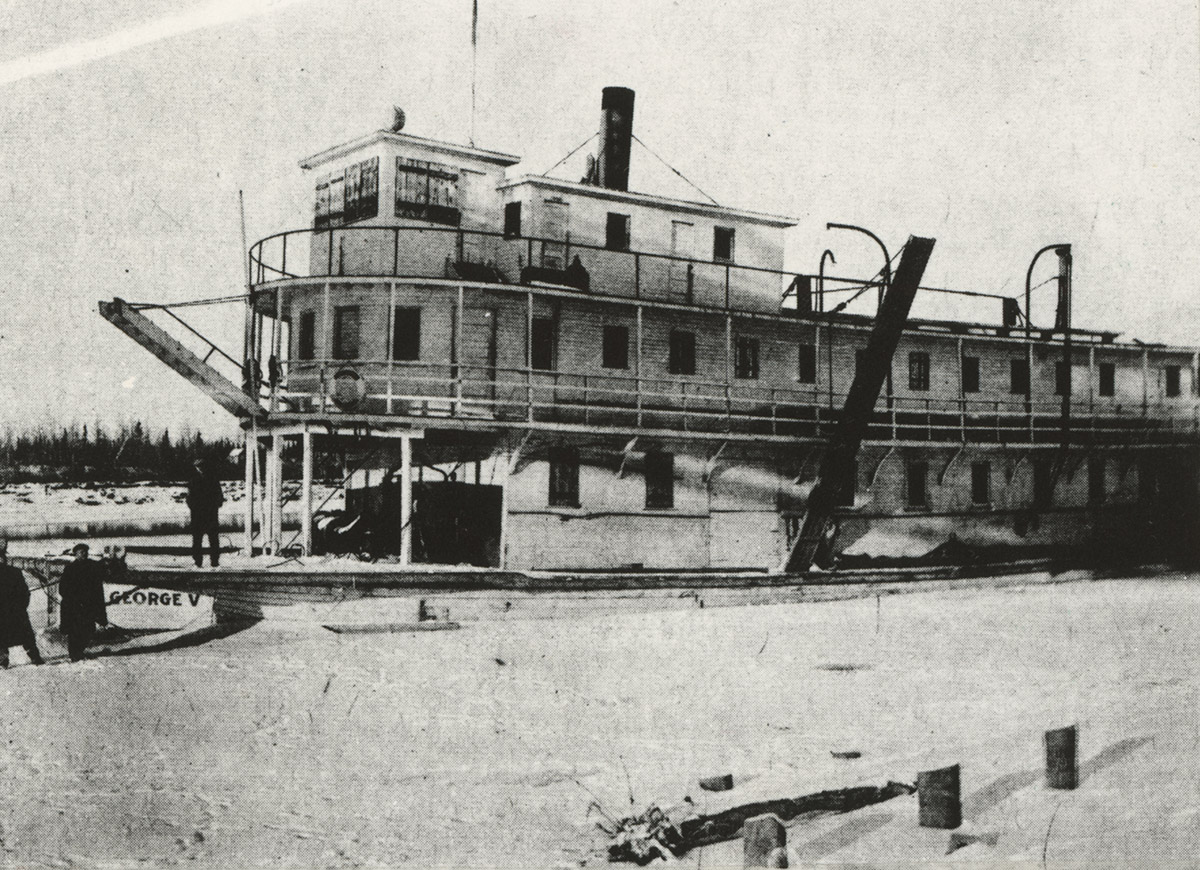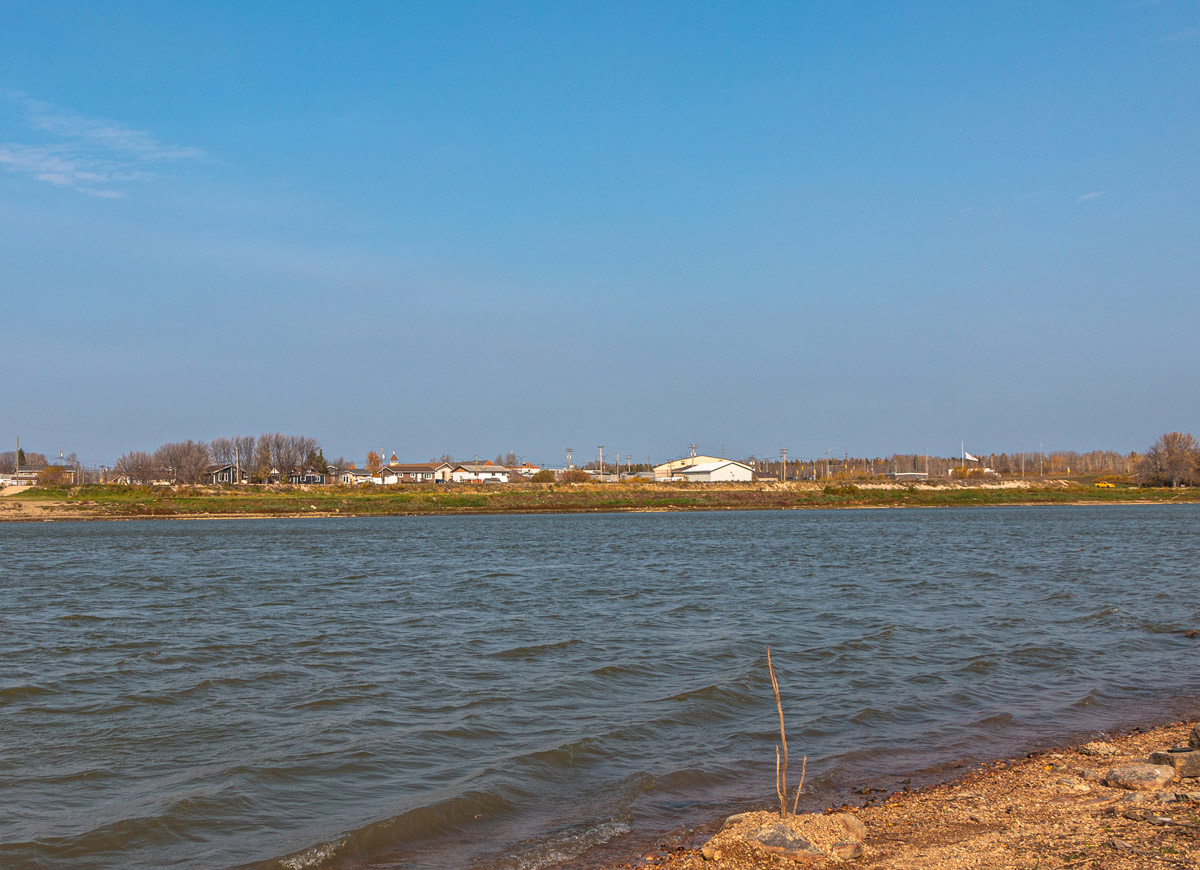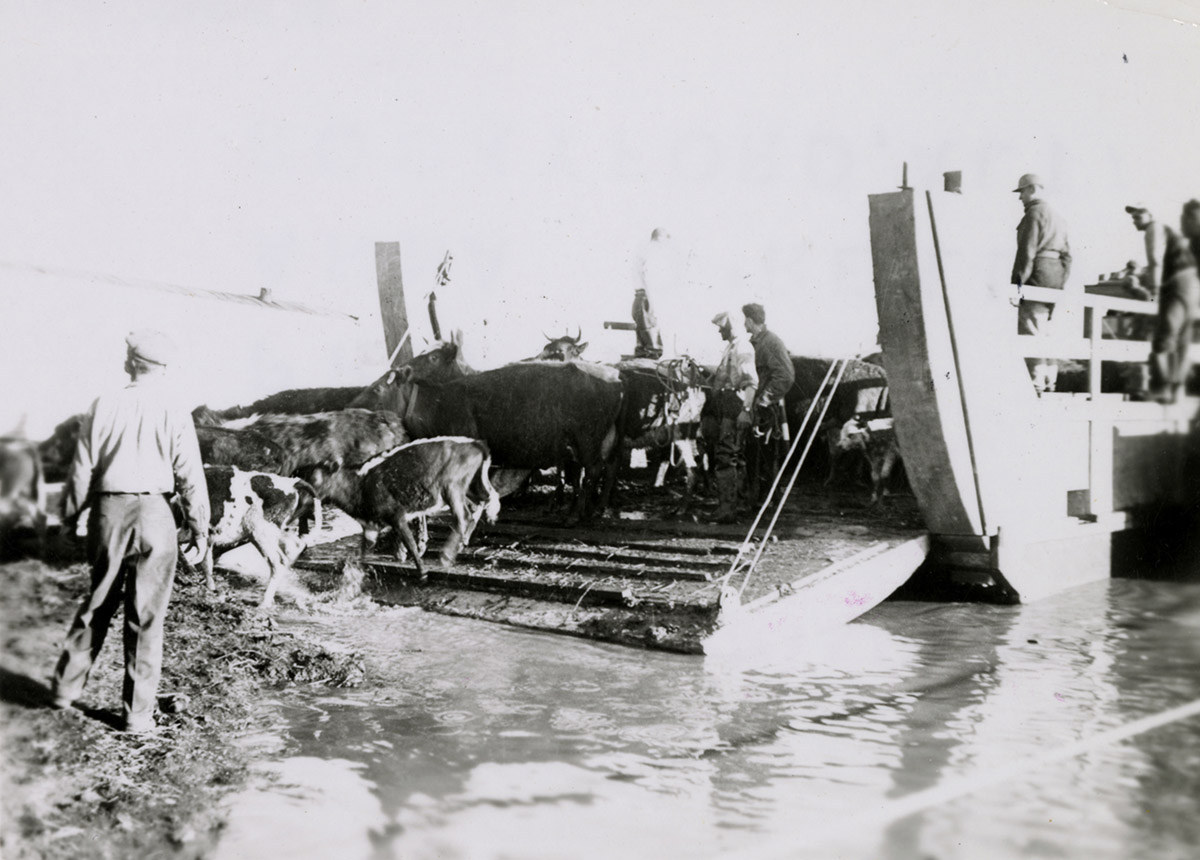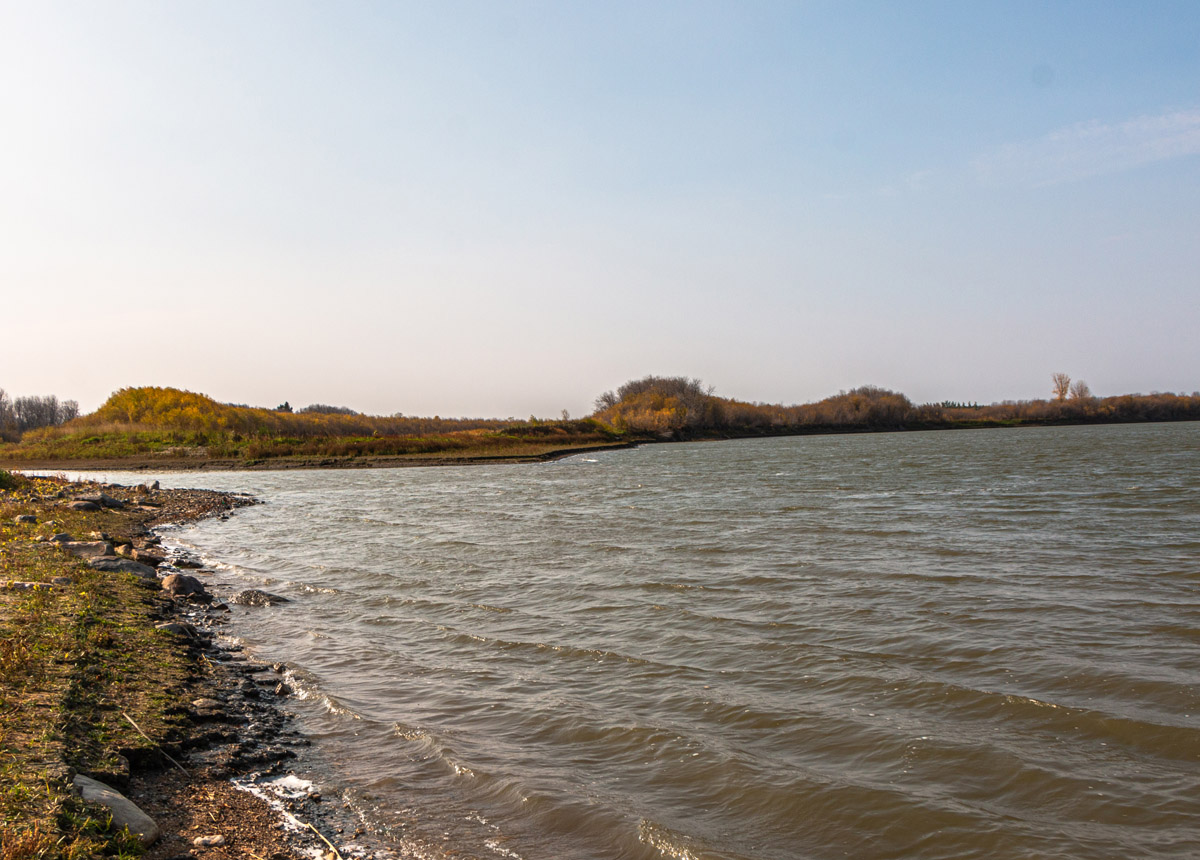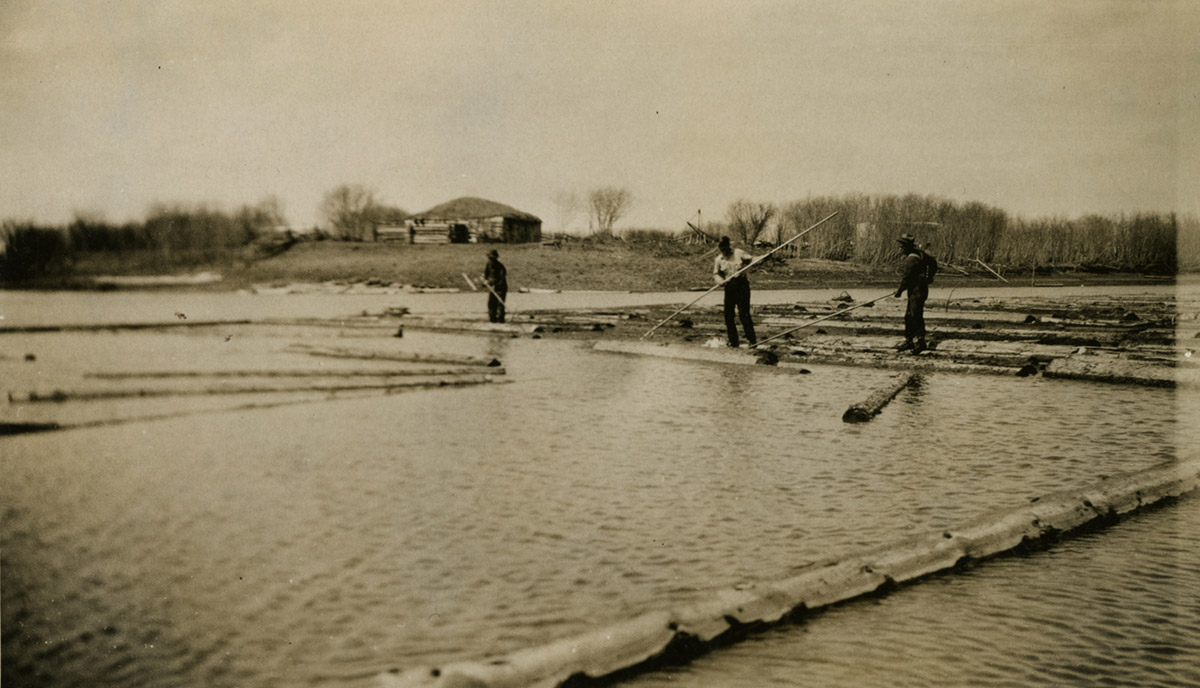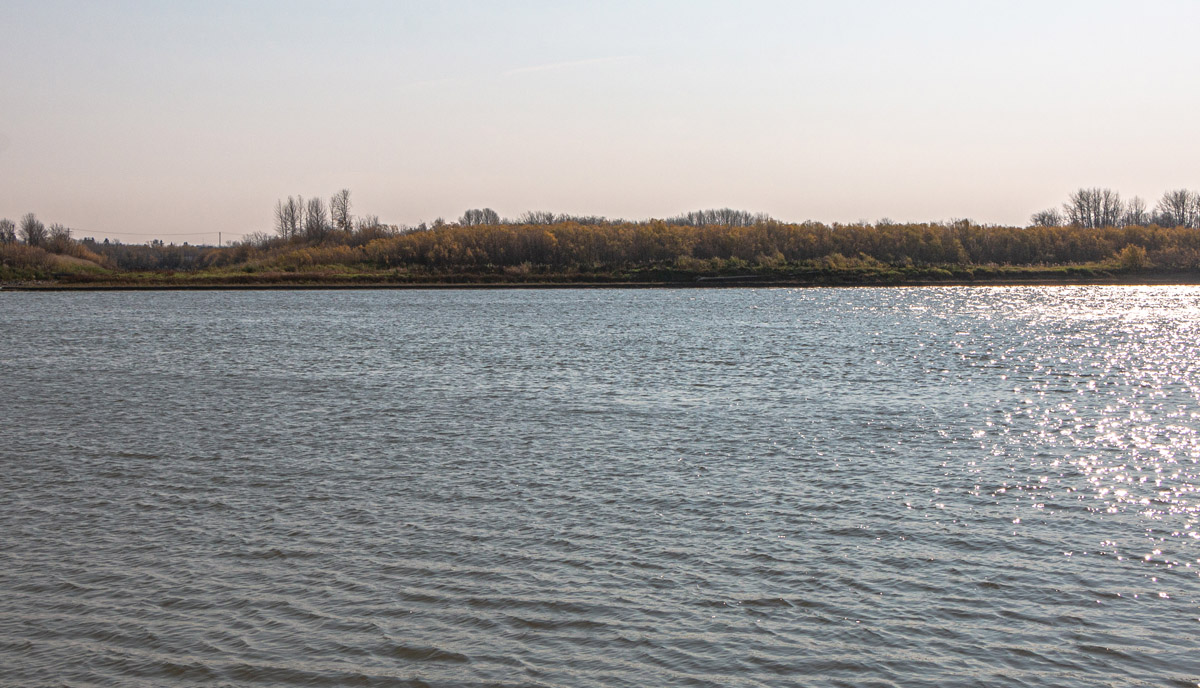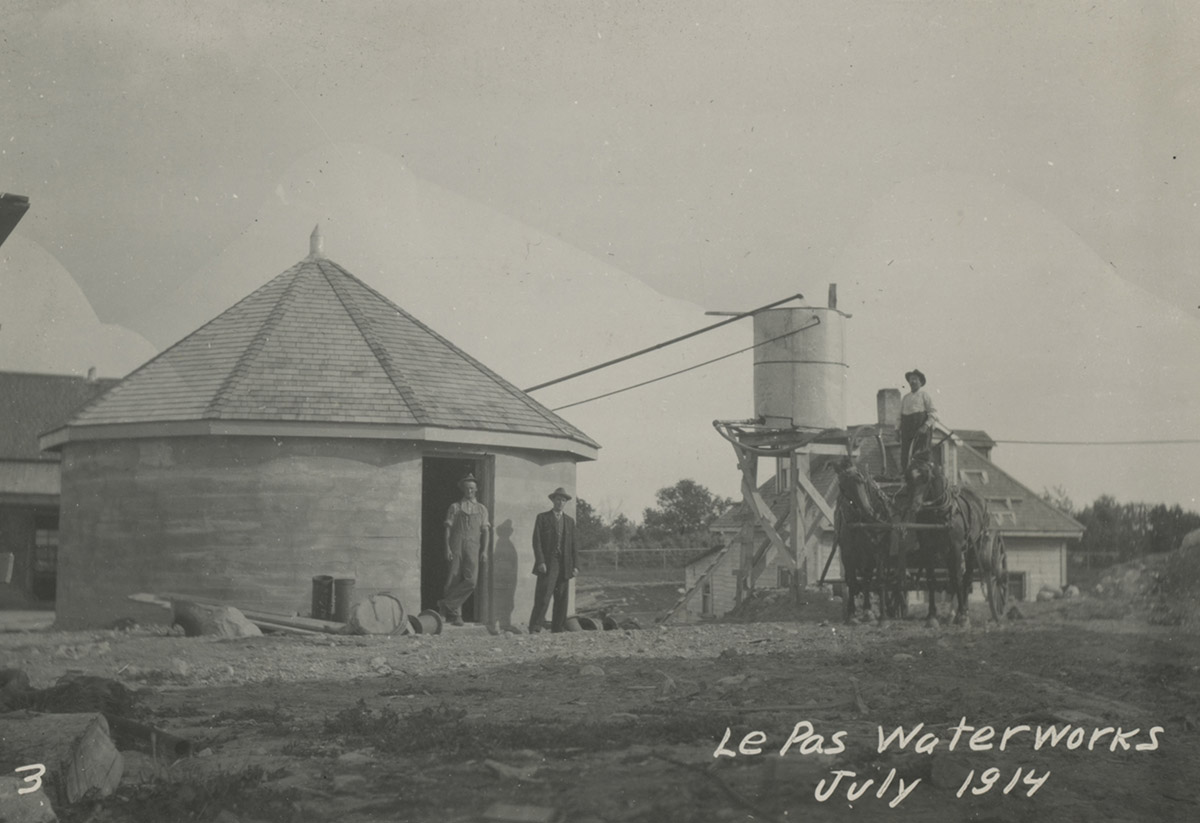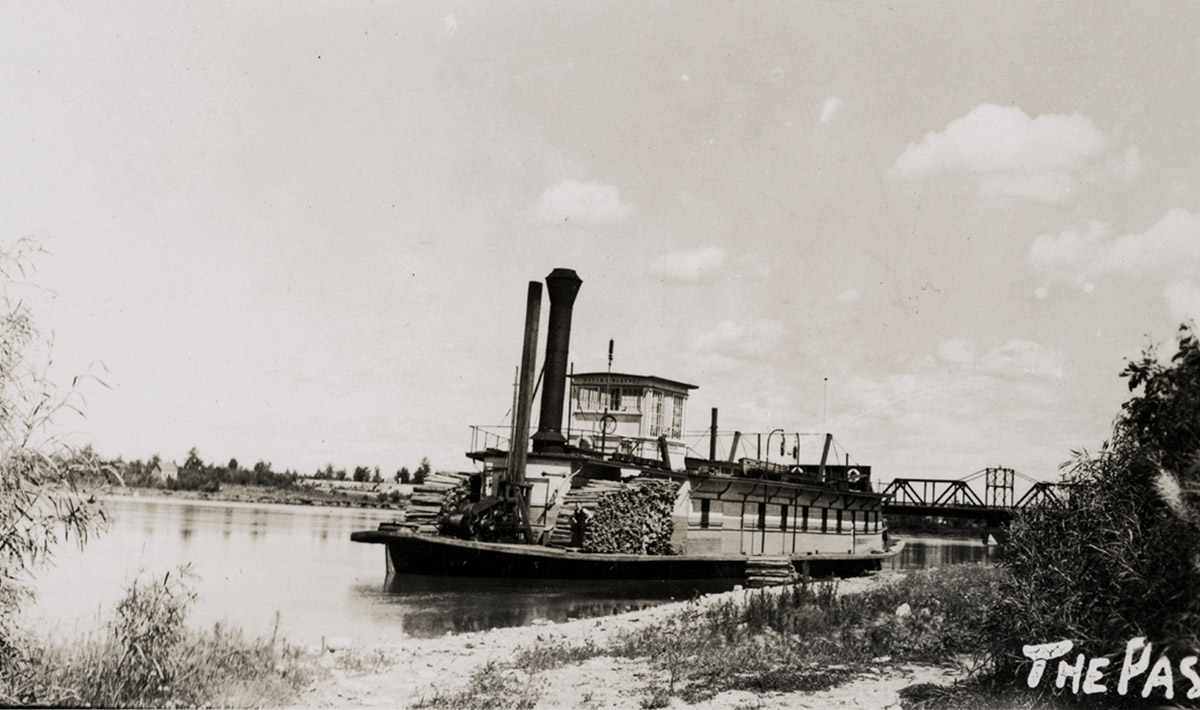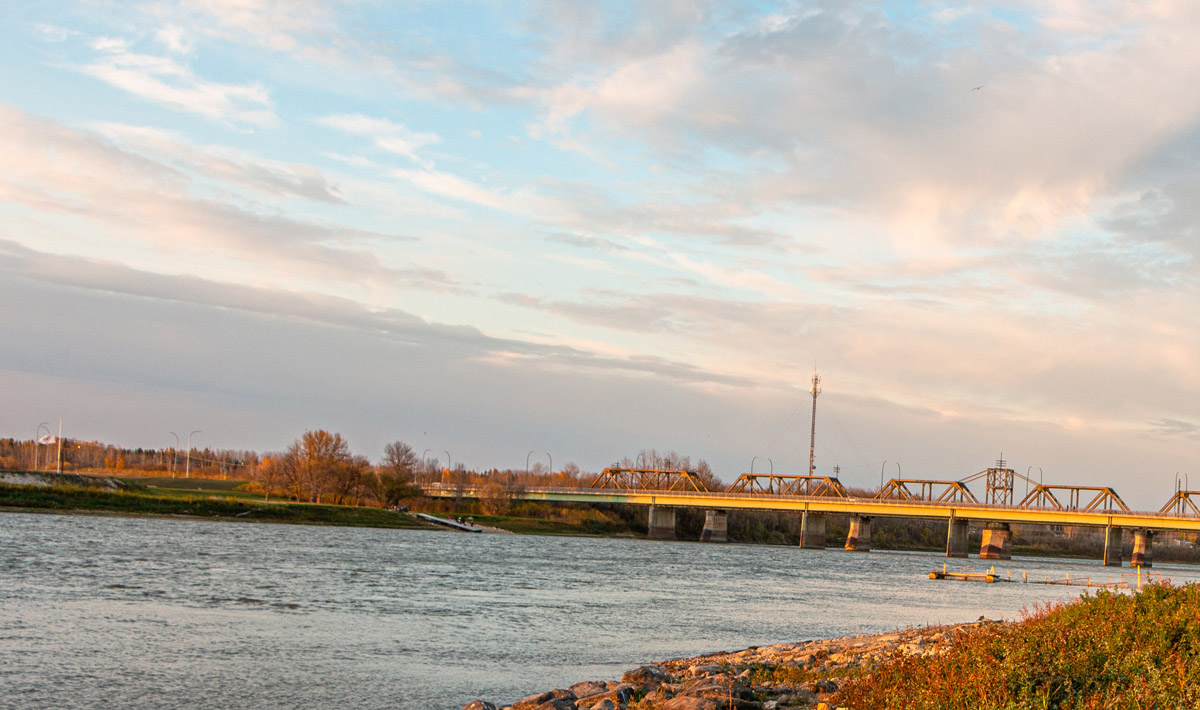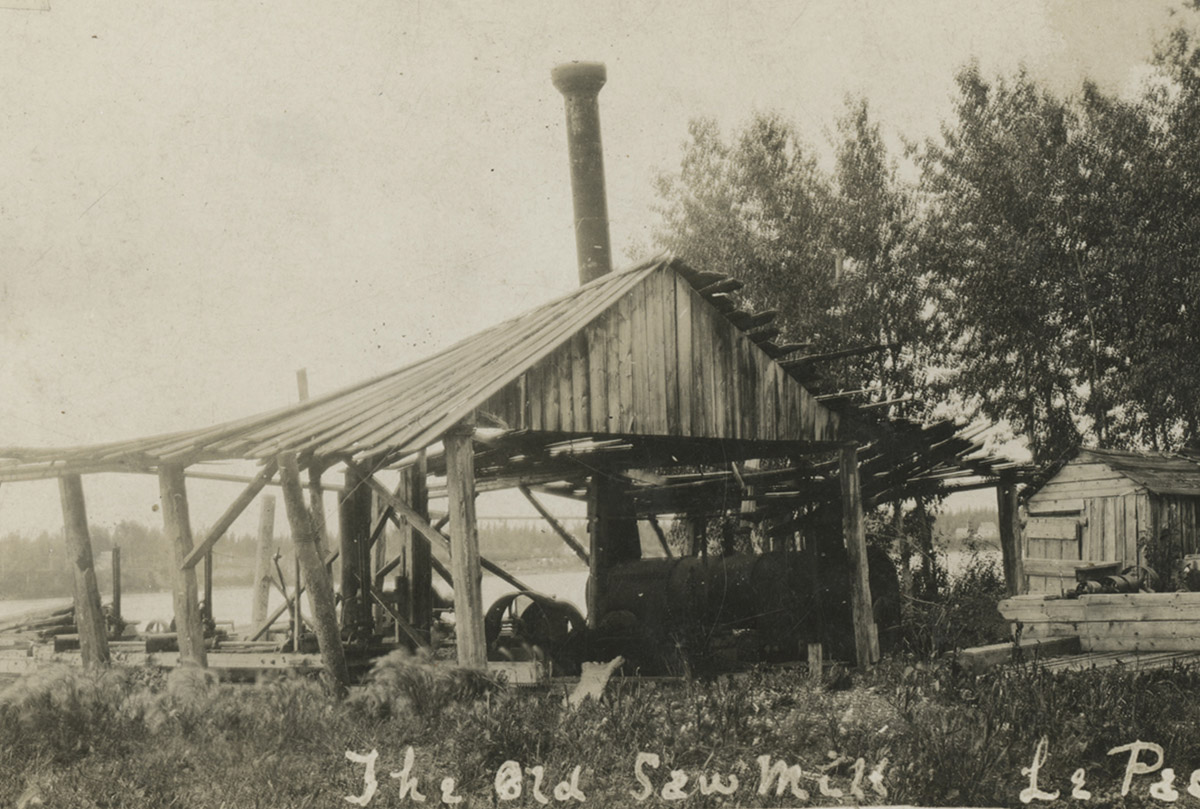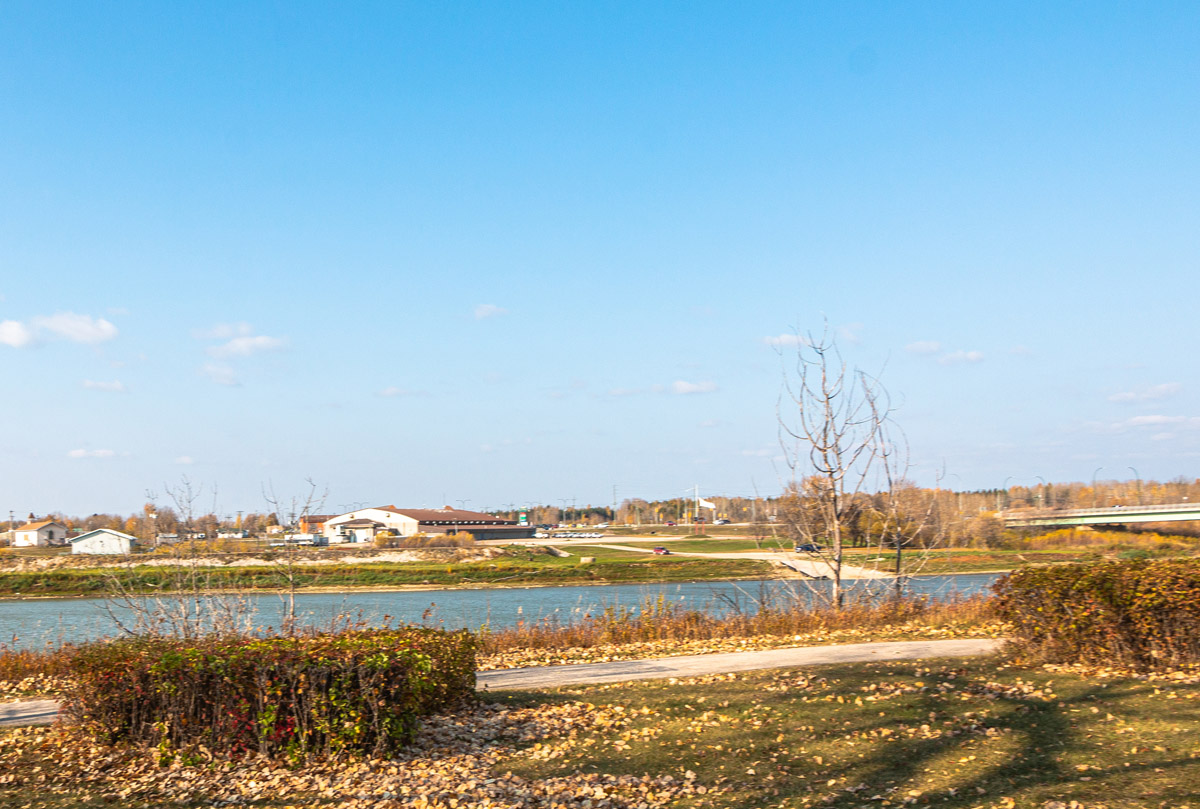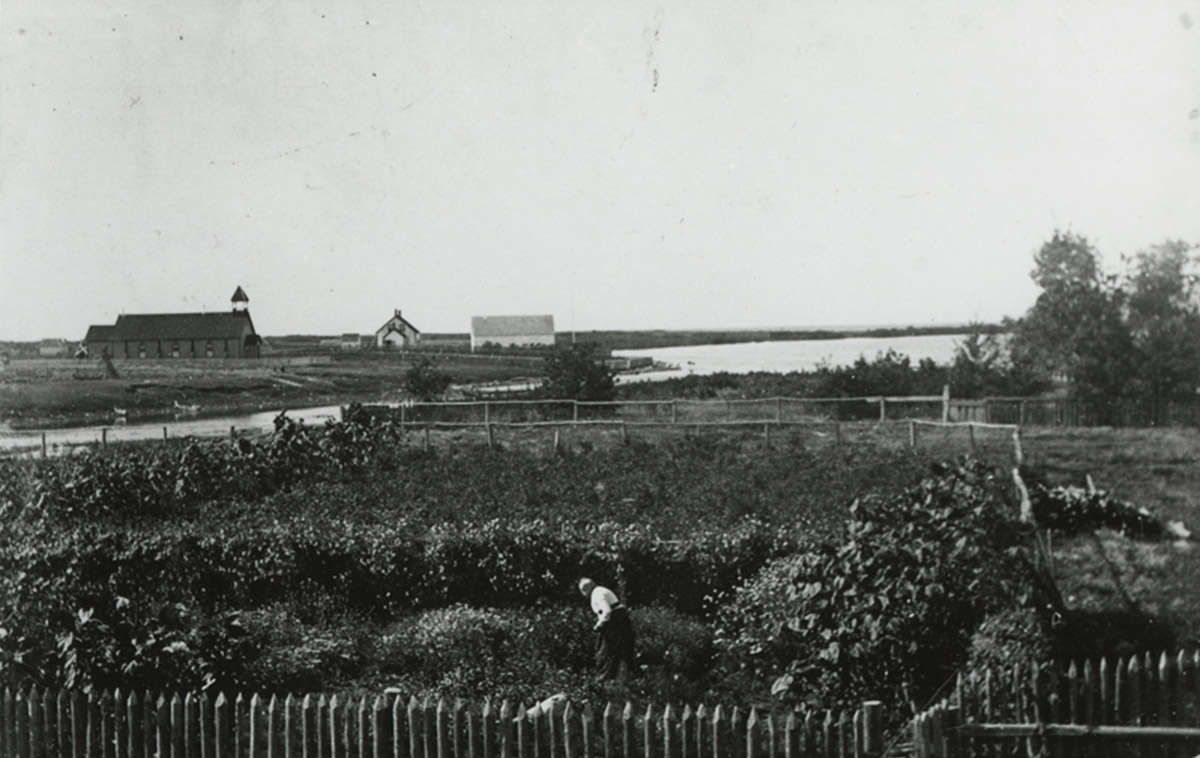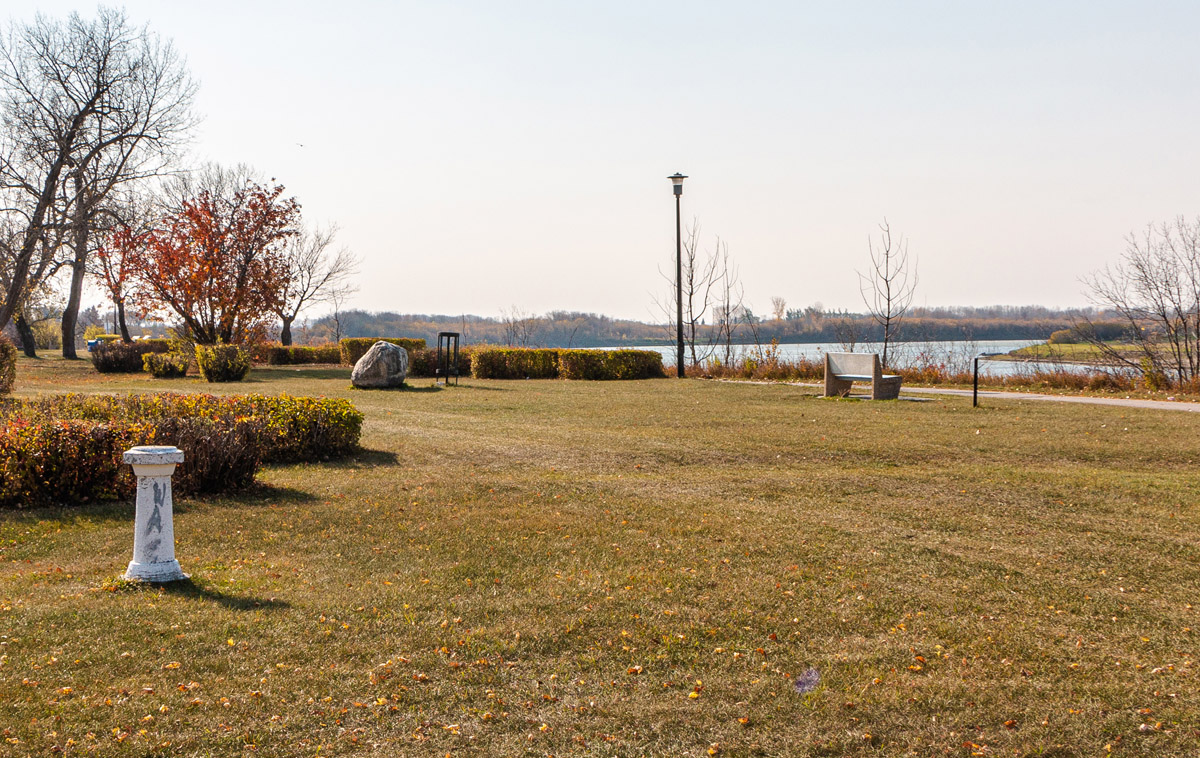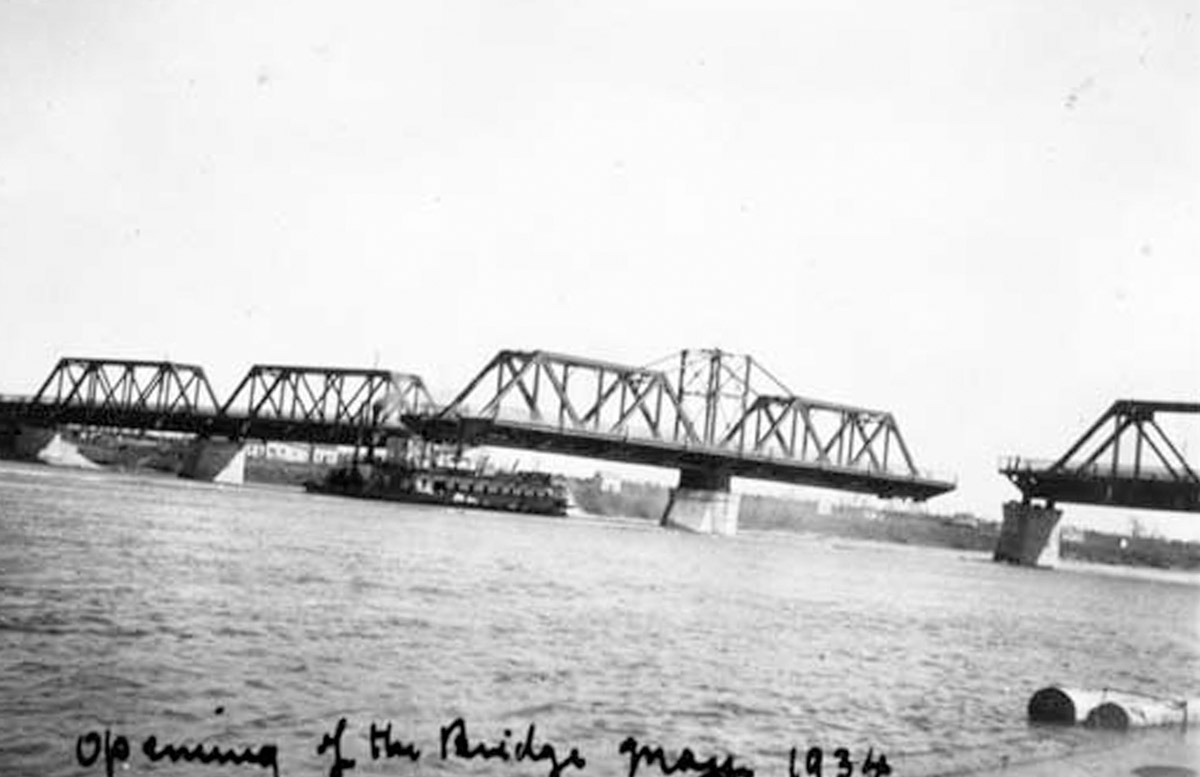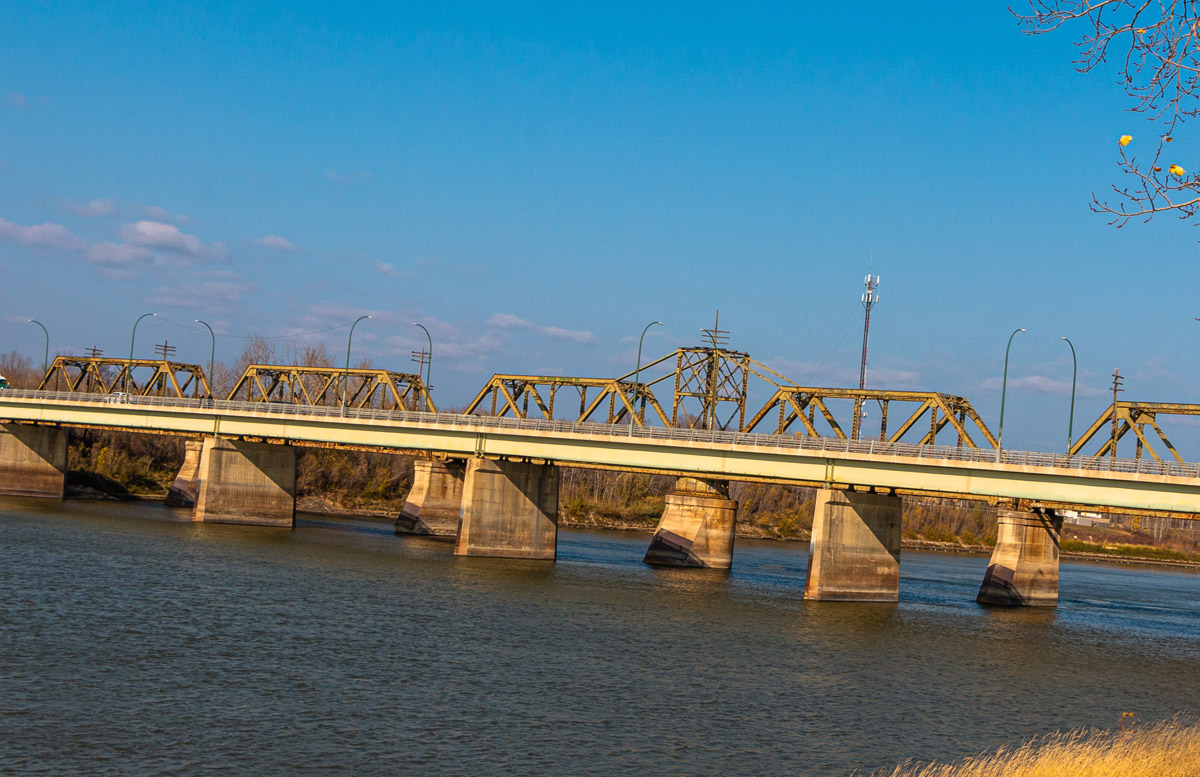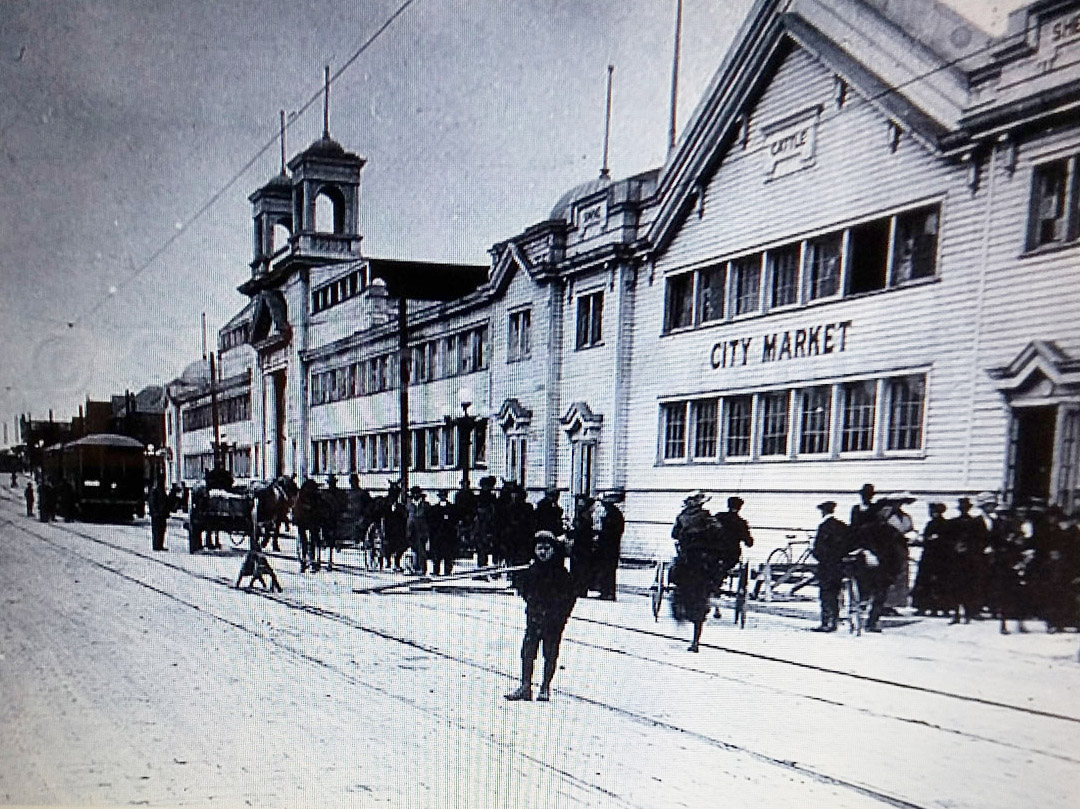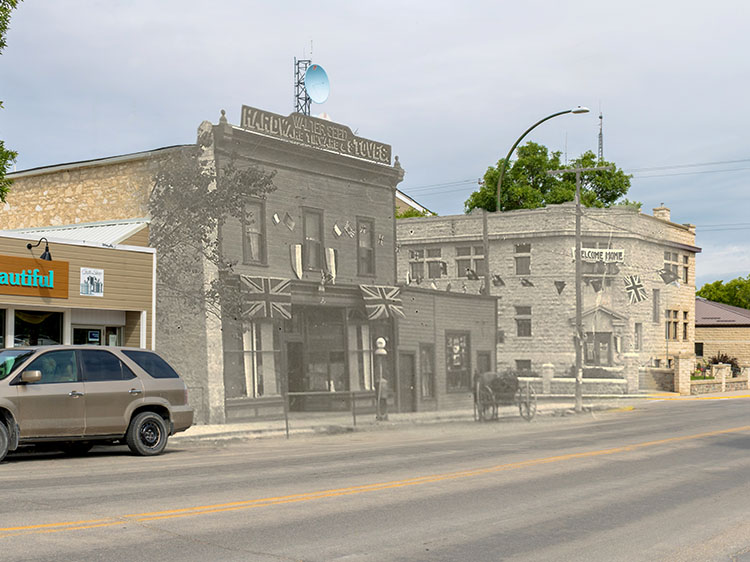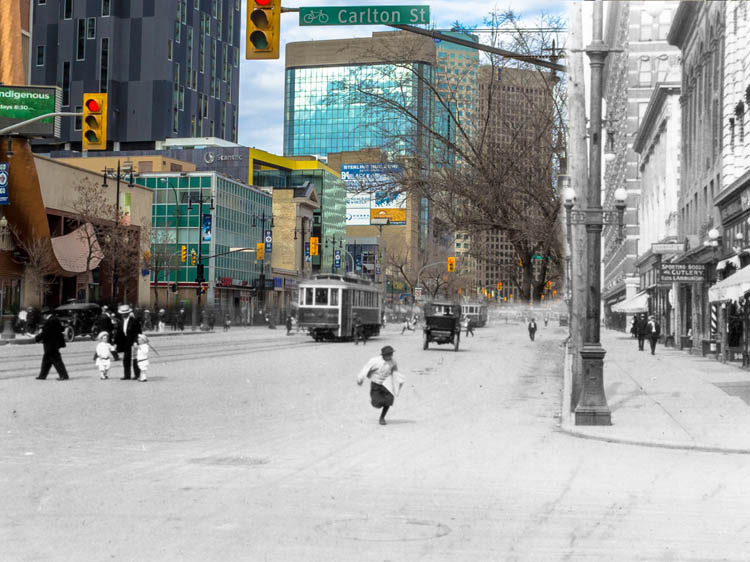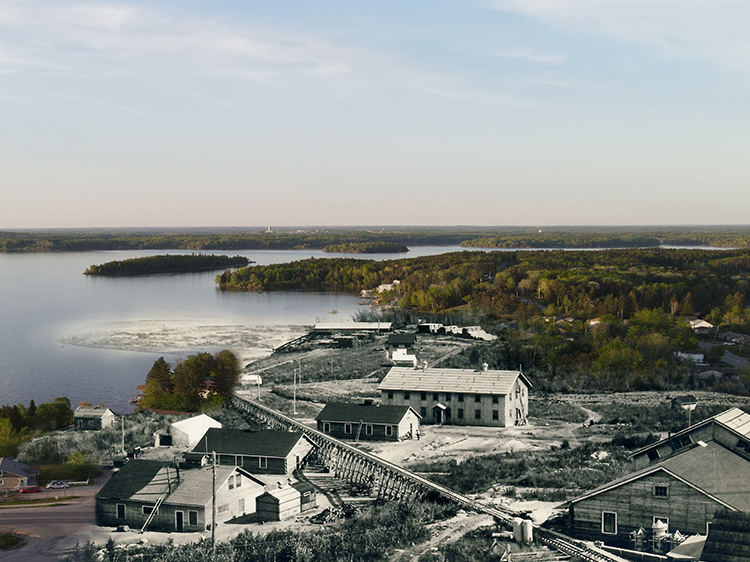Walking Tour
Industry & Transportation
The Saskatchewan River
By Elyse Abma-Bouma
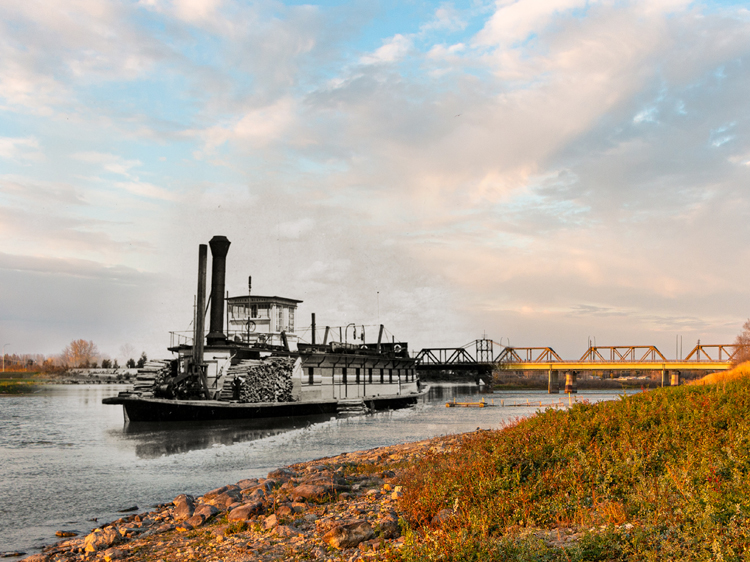
Sam Waller Museum Archives PP2000.10.12
Located at the confluence of three rivers, these waterways have been foundational to The Pas' economic history. In this tour we will explore the steamboats, sawmills, railways, that played such an important part of this town's early history. We will follow the water's edge and discover the stories of The Pas while enjoying the scenic Saskatchewan River.
Route
Beginning at the Greek Orthodox Church we will head towards the river. Following the river north east we will explore various stops and themes ending in the park just before the bridge.
The Sam Waller Museum virtual tours produced by On This Spot were made possible by the financial assistance of the Manitoba Arts Council. The project was initiated from the generous bequest of the estate of Marilyn Dupas for improvement to the Sam Waller Museum exhibits. The Friends of Sam Waller Museum are grateful for the funding they received to have these virtual tours developed to share the history of Sam Waller and the community of The Pas and surrounding area.
1. The Ukrainian Orthodox Church
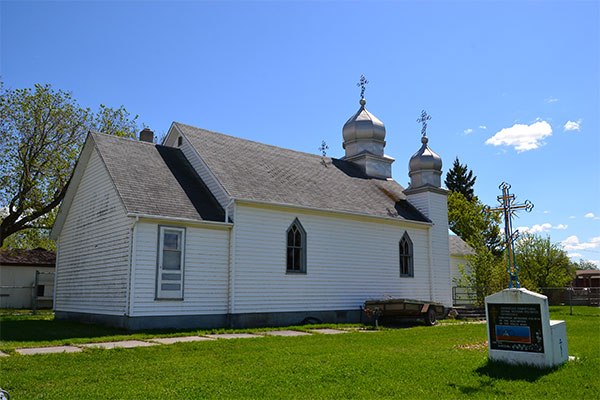
1936
The Ukrainian Orthodox Church, located to your left on the opposite side of the road, was purchased by the congregation in 1962 after they had rented the Presbyterian Church building for a number of years. Prior to this the building was one of the outbuildings for the Hudson's Bay Company fort.1
* * *
"The first service in the newly renovated church took place on December 2, 1862 with Rev. W. Aponiuk of St. Georges' Ukrainian Greek Orthodox Church of Flin Flon."2
Over the years many churches popped up on the banks of the Saskatchewan River. Christ Church was one of the first with the building erected in 1896. The church began in 1840 with Henry Budd who would become the first Cree Anglican priest in the west. The church was originally meant to serve the Indigenous community in the area under the Budd's leadership, but it was later taken over by Rev. James Hunter, who was sent by the denomination to assume control.3
The Grace Apostolic Church, on the other hand, is a relatively recent addition in the history of churches in The Pas. Ross Reid and Maurice Fuller began the Apostolic Church in 1958 beginning with a Vacation Bible School summer program. As many churches did, the Apostolic church met in the homes of its congregation before constructing a building dedicated to worship in 1961.4
2. Swimming in the River
Sam Waller Museum Archives PP2000.6.69
Though they are not here anymore, the docks that once stretched along this bank were used for transporting goods. In this photo we can see a few boys ready for a swim in the river. In the background there is a barge and warehouses.
Rivers are useful for many reasons; they're a source of food and freshwater, and highways for people and goods, harbouring steamboats and log booms. But rivers are also important for recreation and play. Swimming in the Saskatchewan river has been a fondly remembered pastime for generations who grew up in The Pas.
* * *
Summer entertainment consisted of playing baseball, soccer and swimming in the Saskatchewan river. The dock in The Pas extended from First street to Byng street and the boats tied up there provided good diving boards.1
Going for a swim was a fundamental part of summer fun in The Pas in the 1920s and 30s. Mary Melko remembers fondly the Sunday outings:
Several Sundays during the summer, we enjoyed a special outing to Clearwater Lake. Twenty-five cents secured a round trip seat on the wooden benches lining the back of Rivalin's Transfer truck. Often as many as three of these trucks full of joyful holidayers would head out for a day of swimming picnicking and playing games at Pioneer Bay.2
In the winter the swimming locations doubled as ice rinks and hosted many hockey games and curling matches. Later on pools would be built and rinks constructed but, even then, people would (and still do) come back to the lakes and rivers in the area for an experience in a natural setting.
3. Boats on the River
Sam Waller Museum Archives PP88.14.2
1919
Taken on the Saskatchewan River in the spring of 1919 we can see the steamboat George V trapped in the ice. Caught in the spring break-up, the hull was no match for the ice shards and the George V was destroyed that year. It was replaced that same spring by the iconic steamship David N. Winton, which used the engine from the George V.1
* * *
Birch bark canoes were a necessary transportation method used by the Cree people for millennia, and later by voyageurs as well. During the fur trade canoes became very important for Indigenous traders to get pelts from the remote trapping grounds to the forts and trading posts. Birch bark proved to be a fantastic material for canoes thanks to its waterproof quality and flexible workable nature. Birch trees are found all across Canada which made repairs and crafting new canoes easier with readily accessible trees along the waterways travelled.2
As the fur trade ramped up larger boats were needed to transport more product. The York boat was named for York Factory on Hudson's Bay, and could hold 2,700 kilograms of cargo. The Hudson's Bay Company recruited men to build York boats at many forts and posts to accommodate the demand to ship furs and supplies across the Canadian hinterland. The York boats also doubled as a shelter when flipped, and were strong enough to avoid damage from river ice and storms.3
Following the muscle-powered canoes and york boats were steam powered ships and later trains. Steamships carried much more cargo than a York boat while requiring much less manpower. Eventually roads and railways were built as well, and the steamships and the riverine highways of Canada were gradually supplanted by technologies that could finally move goods over land. The canoe is still used today and York boats remain an important part of Canada's historic imagination.
4. Moving Animals
Sam Waller Museum Archives PP2002.23.50
ca. 1940s
A barge docks on the riverbank to unload livestock in the early twentieth century. We can see a man standing on the shore and a few men on the barge helping to disembark the cattle on their way to a nearby farm.
Barges became a common scene on the Saskatchewan River in the 1940s being pushed and pulled through the logs and loaded with all sorts of goods. Barges were a blank canvas sort of water transportation, barges could haul tons of product on a flat bed from fuel and livestock to machinery and supplies.1
* * *
I remember the flood of 1948 when the landing barge came up the Carrot River to wash out at Mile 18 (opposite my father's farm) and cross the valley picking up stranded livestock and taking them into town to unload them on the docks at the end of Larose Avenue. It was quite a sight to see cows wandering down main street.2
While it was not a regular occurrence for barges to become rescue boats and a modern Noah's Ark, it was not unusual for the boats to be used for activities other than industry. The Grant family in The Pas remembers fondly how the lumber company would lend out their boats for weekend recreational getaways:
In Summer, a barge would be crowded with men, women and children and the Lumber Company sternwheeler would propel it to Rahls Island for picnics. 3
Barges moved many things up and down the Saskatchewan river and its tributaries. From equipment and machinery, goods and livestock, people and timber to serving as a rescue boat and cruise ship for a weekend away, residents of The Pas made full use of barges for all sorts of activities.
5. Finger Lumber Company
Sam Waller Museum Archives PP94.8.3
1930
Taken from the opposite side of the river this photo shows the bank where you stand from a distance in 1930. Men move logs in the water with pike poles and chains hold banks of logs together to prevent them from floating away. On the banks we can see the sawmill which operated in The Pas for some time providing a breadth of industry for the small town.
* * *
He began his search by asking the Canadian Department of the Interior for a map of timber berths in the Northwest Territories and a list of their owners. During the winter of 1904 and 1905 he and his son, O.G. (Oscar), travelled all over western Canada checking on these berths. His long experience as a lumberman and his entrepreneurial spirit led him to select the Carrot River timber berths of white spruce as the best value.1
Timber was a highly valuable product both inside the country—as Canadian settlers built homes, farms and businesses—and for the export market. Herman Finger began his career as a lumberman when he was only thirteen years old and continued to manage lumber companies for his lifetime. Unlike brick and stone, timber could be more easily harvested and shipped making it an ideal material for building quickly. Logging would primarily take place in the winter when the heat was less and the cold stopped the tree sap from gunking up their saws. The rush was to get the logs to the river banks before spring thaw to avoid the muddy morasses that followed.2
After a fire in 1919, the death of Mr. Finger's business partner and competition from the Prince Albert Lumber Company, Herman Finger decided to sell off the company and moved out of town with his family. The company's land, machinery and facilities went to the Winton brothers (who owned Prince Albert Lumber) and Alvin Robertson.3
6. Waterworks
Sam Waller Museum Archives PP84.514.1
1914
This photo captioned "Le Pas Waterworks" was taken in July of 1914. We can see the waterworks buildings and tower shortly after completion. A man stands atop his horse-drawn wagon and two other men stand by the doorway of the round building in the centre.
Prior to 1914 there was no waterworks system in The Pas; no taps to be turned, no fire hydrants, no flushing toilets and no laundry machines. All of the water hauling and washing was done by hand and was very time consuming.
* * *
...the big fire of 1913, which started in the [Cecil] hotel, burned down the theatre, and every building was destroyed likewise on the one side of the street, until it reached the shacks which are still standing at the corner of Fischer Avenue and Third Street. A bucket brigade was all there was to fight the blaze there being no waterworks.1
When the waterworks were finally installed in 1914 it was a time of celebration. Olive Wadelius remembers all of the excitement from when she was just a child:
I was about 12 or so when waterworks were installed on Patrick Avenue and that was a major event.2
Life before running water was difficult, water had to be hauled from wells or the river on a daily basis for washing, cooking and bathing. Even after Le Pas Waterworks began operation, itt was still decades before all homes in the town were hooked up to running water, Dorthy Readers recalls a bleak time in the 1940s when her husband was away at war and she was left home raising her children:
She was alone with four young children barely knowing a soul. Not even waterworks! She remembers also that houses would sell for thier taxes or for less than $1000.3
Being without running water made hard times harder, especially for mothers whose supports were away at war, work or passed away. It's difficult to imagine having to predict how much water your family would need for a day and haul it from the river to your house, but this was the reality for everyone who lived in The Pas' early days.
7. Steamboats
Sam Waller Museum Archives PP2000.10.12
ca. 1940s
In this photo we can see the David N. Winton Steamboat which became an icon on this stretch of the Saskatchewan River. Notice the ship's deck is loaded up with lumber. In the background you can see the railway bridge that had been recently completed. This was a typical moment in The Pas when the lumber industry was at its height.
* * *
The long expected steamer "North-Cote" came puffing up in sight. They blew the whistle so loud they made the very cattle rear up their heels…people of all ages and sexes were no less excited at the sight of the boat, the first boat of the kind to be seen by them all their life. -Reverend Henry Budd (August 26, 1874)2
Most riverboats were owned by the Hudson's Bay Company and the Winnipeg and Western Transportation Company, but the most well known in The Pas were those owned by the Ross Navigation Company, the S.S.The Pas and S.S. David N. Winton:
In 1911 Captain Ross had a second boat built, The Pas. He organized the Ross Navigation Company, which in time operated six vessels…These boats operated from Cumberland Lake to Cedar Lake, and up navigable tributaries such as the Carrot River.3
The Jack Winton and David N. Winton steamboats were owned and operated by the Finger Lumber Company (later sold and renamed The Pas Lumber Company). From 1912 to 1953 these boats were part of the scenery in The Pas, coming and going with loads of lumber and livestock. The David N. Winton was an impressive 120 feet in length and had been remade with the engine from the S.S. George V after it tragically sunk in the ice break-up of 1919.4
The David N. Winton for over thirty years pulled log rafts down the Carrot River. When she was sunk by the action of ice in the spring of 1954, the last of the sternwheel steamers disappeared from the river.5
It was right here in The Pas that the era of the steamboats on the Saskatchewan River ended. A fitting place considering its place on the Saskatchewan and Carrot Rivers and The Pas' legacy or river transportation.
8. Sawmill Industry
Sam Waller Museum Archives PP2.26.7
ca. 1920s
In this photo we can see the ruins of an old sawmill that was said to have operated here prior to the Mission being built. The sawmill was in operation until about 1908. Many sawmills followed after 1908 in The Pas.
Timber is vital to building early communities. Wooden structures are erected more quickly than stone or brick and the process for logging is often much quicker than establishing quarries and such for obtaining limestone for example. Another fantastic property of timber is that it floats, this means that it is more easily stored and transported on rivers making it an ideal construction material in many ways.
* * *
In 1884 the Pas Band had 104 log houses and 28 stables, far more than they had had in 1875. Most houses were made of logs with thatched or mud roofs.1
The initial 246 acres that were said to be full of "fine pine" according to the Indian agent, but these proved to be insufficient for the needs of the Pas Band. In 1894 the boundaries were changed to include an adequate timber berth for the growing community. By 1902 the band was building fifteen new houses to add to the twelve that were already finished.2
In 1907 the Pas Band required more timber to continue at the rate they were building. They expanded their logging territory and built a sawmill in 1908 which provided the 120,000 feet of lumber they needed for ongoing construction projects.3
The Finger Sawmill also saw potential in the Pas Band's lumber industry. By 1909 the reserve mill was no longer in operation but, instead they were sawing logs for Herman Finger's company.
The opening of the Finger Lumber mill and, concurrently, the inauguration of work on the Hudson Bay Railway from the Pas, had serious repercussions on the Band's timber reserves, just as it had on the operations of its sawmill.4
It was found, also, that the Finger Lumber Mill had cut a road through the Pas Band's timber reserves illegally. When asked about it he pleaded ignorance saying that he did not know his application had been denied to log there and that it should be chocked up to a clerical error. In the end the board of trade sided with Mr. Finger and he faced no repercussions for the theft.5
Over the years many other sawmills and logging operations would begin their business in The Pas. The Pas Band's sawmill would be slowly undermined and many of its labourers went to work for the Finger sawmill. Herman Finger's lumber company would be sold and become The Pas Lumber Company which retained the operational capacity and many employees from the Finger Lumber Company.
9. Mission Island
Sam Waller Museum Archives PP89.7.1
ca. 1890s
This spot was once the edge of the Mission House garden. We can see someone working in the garden with the Mission buildings in the background including the church and school. When the river would rise, as it is in this photo, the Mission would become separated from the mainland making it an island for part of the year. This was referred to as Mission Island by locals.
* * *
There was also a school that was a part of the Mission. The MacKay Indian Residential School was began construction in 1912 when the Department of Indian Affairs deemed it essential for assimilation of the Indigenous nations residing in The Pas. The school was named for Archdeacon John Alexander Mackay and opened in 1915 with a class of 81 students. The school burned down in 1933 and the government did not deem reconstruction necessary until 1953 when the new building was constructed in an entirely different town. In the meantime, students were sent to surrounding schools.2
Jamie Harvey was a student of the MacKay Residential School when it was moved to Dauphin. He recalls the place as a legacy of pain, suffering, and a "common experience" of cultural genocide and loss:
They forced kids on the reservations to leave their families and come to the schools from the middle of August to the end of June every year…The point was to force them to learn English and math and remove their language and culture from them.3
The Mission began with good intentions from Rev. Henry Budd however, his vision was quickly corrupted by the Canadian Government who sought to snuff out Indigenous culture. How fortunate we are that Indigenous people still stand, resilient and proud of their culture, despite the violence they've endured.
10. The Importance of Bridges
Sam Waller Museum Archives PP2000.6.32
1934
Taken in 1932 we can see the steamboat David N. Winton travelling through the railway swing bridge. The bridge was built for the railway by the Hudson's Bay Company and a vehicle and pedestrian bridge was added in the 1960s. The swing design allowed it to accommodate the passage of steamboats on the Saskatchewan River.1
* * *
The First World War suspended construction for a period due to tight finances and less workers available. In the 1920s it was decided that the railway would not start at Port Nelson, which was chosen for its land accessibility, but Churchill instead. The harbour at Churchill was much deeper and made for better bay access. The railway was finally completed in April of 1929 with the harbour at Churchill finished in1931.3
The Cornelius Bignell Bridge was built as a companion to the Hudson Bay Railway Bridge to accommodate the diversifying methods of transportation, namely vehicles. Finished in 1969 the bridge was named for Cornelius Bignell, Chief of the Opaskayak Cree Nation from 1945 to 1964. The bridge joined The Pas with Opaskwayak and the rest of northern Manitoba making way for better transportation and physical joining of communities.4
Bridges are symbolic and functional pieces of community. The bridges over the Saskatchewan join communities tangibly for industry, transportation and travel, but they also join the Opaskayak Cree Nation with the town of The Pas creating a tangible bond between places.
Endnotes
1. The Ukrainian Orthodox Church
1. The Pas Historical Society, "The Pas: Gateway to Northern Manitoba." 98-99.
2. The Pas Historical Society, The Pas: Gateway to Northern Manitoba.99.
3. The Pas Historical Society, The Pas: Gateway to Northern Manitoba. 91.
4. The Pas Historical Society, The Pas: Gateway to Northern Manitoba. 95.
2. Swimming in the River
1. The Pas Historical Society, The Pas: Gateway to Northern Manitoba. 172.
2. The Pas Historical Society, The Pas: Gateway to Northern Manitoba. 365.
3. Boats on the River
1. Neustaedter, Laurel, The Pas 100 Years. 94.
2. Marsh, James H.. "Birchbark Canoe." The Canadian Encyclopedia.
3. Foster, John E.. "York Boat." The Canadian Encyclopedia.
4. Moving Animals
1. The Encyclopedia of Saskatchewan, "Ferries and Barges." Online
2. The Pas Historical Society, The Pas: Gateway to Northern Manitoba. 286.
3. The Pas Historical Society, The Pas: Gateway to Northern Manitoba. 265.
5. Finger Lumber Company
1. McCarthy, Martha, Harvesting the Northern Forest. 16.
2. Wynn, Graeme. "Timber Trade History." The Canadian Encyclopedia.
3. McCarthy, Martha, Harvesting the Northern Forest. 22.
6. Waterworks
1. The Pas Historical Society, The Pas: Gateway to Northern Manitoba. 415.
2. The Pas Historical Society, The Pas: Gateway to Northern Manitoba. 141-42.
3.The Pas Historical Society, The Pas: Gateway to Northern Manitoba. 403
7. Steamboats
1. Peel, Bruce, Steamboats on the Saskatchewan. 27.
2. Peel, Bruce, Steamboats on the Saskatchewan. 28.
3. Peel, Bruce, Steamboats on the Saskatchewan. 225.
4. Peel, Bruce, Steamboats on the Saskatchewan. 225.
5. Peel, Bruce, Steamboats on the Saskatchewan. 228.
8. Sawmill Industry
1. McCarthy, Martha, Harvesting the Northern Forest. 6-7.
2. McCarthy, Martha, Harvesting the Northern Forest. 7.
3. McCarthy, Martha, Harvesting the Northern Forest. 11.
4. McCarthy, Martha, Harvesting the Northern Forest. 12.
5. McCarthy, Martha, Harvesting the Northern Forest. 12.
9. Mission Island
1. Neustaedter, Laurel, The Pas 100 Years. 80.
2. Larsson, P, " MacKay Residential School." Online.
3. Ross, Bobby Jr., "In Canada, seeking redemption for a long, dark chapter."Online.
10. The Importance of Bridges
1. Neustaedter, Laurel, The Pas 100 Years. 129.
2. Parks Canada, "Commemorating the Construction of the Hudson Bay Railway," Online
3. Parks Canada, "Commemorating the Construction of the Hudson Bay Railway," Online
4. Neustaedter, Laurel, The Pas 100 Years. 152.
Bibliography
The Encyclopedia of Saskatchewan, "Ferries and Barges." Accessed March 2, 2022. https://esask.uregina.ca/entry/ferries_and_barges.jsp
Foster, John E.. "York Boat." The Canadian Encyclopedia. Historica Canada. Article published February 07, 2006; Last Edited February 21, 2020.
Goa, David J.. "Orthodox Church." The Canadian Encyclopedia. Historica Canada. Article published February 07, 2006; Last Edited December 16, 2013.
Larsson, P, " MacKay Residential School." September 9, 2015. https://eugenicsarchive.ca/discover/institutions/residential/540f3dfb05
McCarthy, Martha, Harvesting the Northern Forest: A History of the Forest Industry in The Pas and Area. The Pas History and Heritage Society Inc. (1997)
Marsh, James H.. "Birchbark Canoe." The Canadian Encyclopedia. Historica Canada. Article published May 29, 2006; Last Edited January 18, 2021.
Neustaedter, Laurel, The Pas 100 Years. Manitoba Local Histories Collection at Sam Waller Museum (2012)
Parks Canada, "Commemorating the Construction of the Hudson Bay Railway," Manitoba Historical Society, No. 57 (February 2008). http://www.mhs.mb.ca/docs/mb_history/57/hudsonbayrailway.shtml
The Pas Historical Society, The Pas: Gateway to Northern Manitoba. The Pas, Manitoba (1983) http://hdl.handle.net/10719/2278811
Peel, Bruce, Steamboats on the Saskatchewan. Prairie Books (Saskatoon) 1972.
Ross, Bobby Jr., "In Canada, seeking redemption for a long, dark chapter." The Christian Chronicle (May 22, 2017) https://christianchronicle.org/in-canada-seeking-redemption-for-a-long-dark-chapter
Wynn, Graeme. "Timber Trade History." The Canadian Encyclopedia. Historica Canada. Article published July 16, 2013; Last Edited July 24, 2015.





